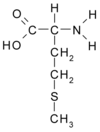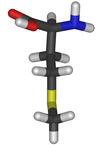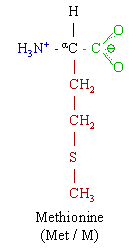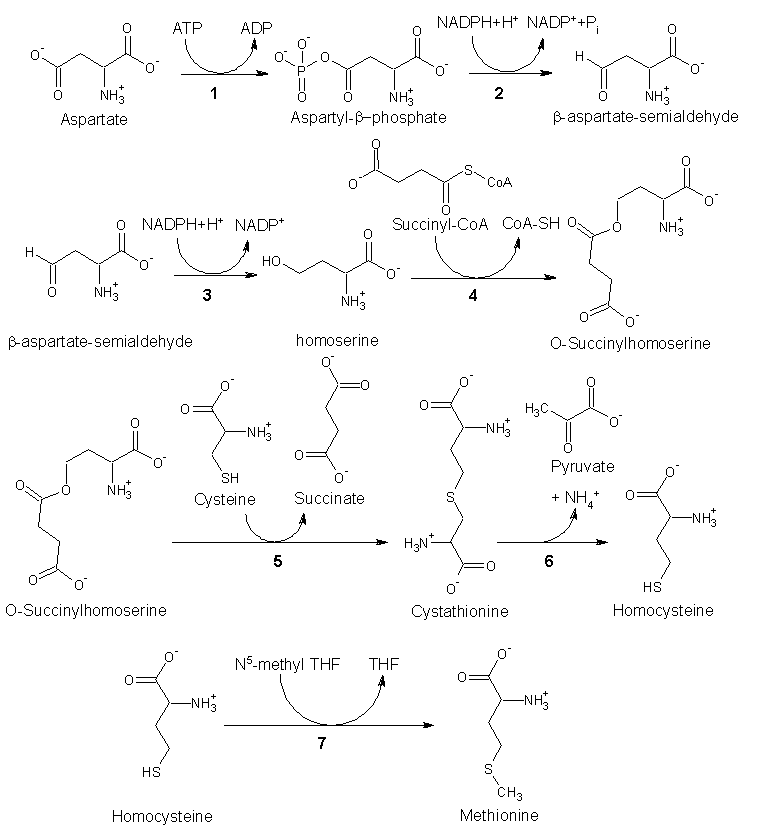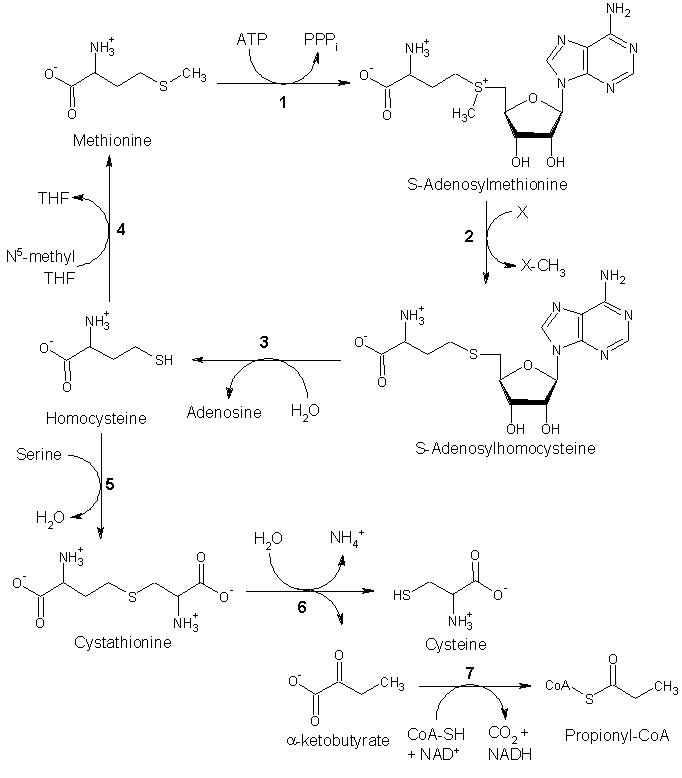Description
Methionine (C5H11NO2S) is an essential, sulfur-containing amino acid. It is the source of sulfur for numerous compounds in the body, including the amino acids cysteine and taurine. The body uses sulfur to influence hair follicles and promote healthy hair, skin, and nail growth. Sulfur also increases the liver's production of lecithin (which reduces cholesterol), reduces liver fat, protects the kidneys, helps the body to excrete heavy metals, and reduces bladder irritation by regulating the formation of ammonia in the urine. Methionine is a lipotropic--a nutrient that helps prevent fat accumulation in the liver, and usually helps detoxify metabolic wastes and toxins.
S-adenosyl-L-methionine (SAM, or SAMe)is an active compound made from methionine and adenosine triphosphate (ATP), an enzyme found in muscle tissue. SAMe is manufactured within the body and is found in almost every tissue, but it can also be made synthetically. It acts as a methyl donor in a variety of biochemical pathways. Methylation reactions are essential for the detoxification of harmful products of metabolism, and the synthesis of numerous physiological agents including neurotransmitters, cartilage, and glutathione. (Glutathione is a chemical that plays an important role in biological oxidation-reduction processes, and as a coenzyme. It can combine with toxic substances to form water soluble compounds that can be excreted through the kidneys.)
Methionine is considered essential because it cannot be manufactured in the body and must be obtained through diet. This particular amino acid is found only in meat, fish, eggs, and dairy products. Natural and synthetic methionine supplements are available, as well as supplements containing SAMe.
General use
Acetaminophen overdose
Methionine is used to treat acetaminophen (paracetamol) poisoning to prevent liver damage. Preparations containing both methionine and acetaminophen have been formulated for use in situations where overdosage may occur.
Arthritis
Most people with arthritis rely on continuous doses of non-steroidal, anti-inflammatory drugs (NSAIDs) like ibuprofen, aspirin, and naproxen for pain relief. SAMe has several advantages over these standard painkillers. It provides effective pain relief and has fewer side effects than these drugs. SAMe also meets with a higher rate of tolerance than other drugs, which is a significant issue for arthritis sufferers. While NSAIDs can cause gastrointestinal bleeding, SAMe can protect against injury to the stomach. Another advantage is that SAMe may actually have a protective effect on joints and even repair cartilage.
Depression
SAMe is beneficial for most forms of depression. In Europe, SAMe is prescribed more often than any other type of antidepressant. Many studies have shown SAMe to be as effective as other antidepressant drugs. It works more quickly and has fewer side effects. SAMe may boost the activity of several brain chemicals involved in mood, such as norepinephrine, dopamine, and serotonin.
Liver function
Methionine levels help determine the liver's concentration of sulfur-containing compounds and SAMe improves and normalizes liver function. SAMe is used in Europe in the treatment of cirrhosis and damage caused by alcohol. It is essential for the production of glutathione. Methionine itself has a protective effect on glutathione and prevents depletion during toxic overload, which can protect the liver from the damaging effects of toxic compounds.
Through methylation, SAMe is able to inactivate estrogens to prevent estrogen-induced cholestasis (suppressed bile flow) in pregnant women and those on oral contraceptives. It also increases membrane fluidity, restoring several factors that promote bile flow. Treatment with SAMe can also help decrease serum bilirubin (pigment in the blood that can cause jaundice) in patients with Gilbert's syndrome, a condition characterized by a chronically elevated serum bilirubin level.
Neurological disorders
SAMe improves the binding of neurotransmitters to receptor sites in the brain. It is essential for the regeneration of neuron axons following injury, and for the formation of myelin sheaths (a fatty substance) that surround axons. Alzheimer's and Parkinson's patients have very low levels of SAMe, and methionine may help treat some symptoms of Parkinson's disease .
Persons with AIDS have low levels of methionine, which may explain some of the nervous system deterioration that can occur to cause symptoms including dementia. Methionine may improve memory recall in persons with AIDS-related nervous system degeneration, and SAMe may be used in the treatment of HIV-related motor and sensory changes in the extremities.
Other uses
In Europe, SAMe has been used in clinical studies to treat anxiety, schizophrenia, demyelination diseases, and dementia. Oral doses of methionine have also been given to lower urinary pH and to help in the treatment of liver disorders. SAMe's ability to inactivate estrogens supports the use of methionine in conditions of presumed estrogen excess such as PMS. Methionine in combination with several antioxidants may reduce pain and recurrences of attacks of pancreatitis (inflammation of the pancreas). SAMe also improves the symptoms of fibromyalgia patients, who suffer from chronic muscle pain, non-restorative sleep, and profound fatigue.
Preparations
Amino acid requirements vary according to body weight. Most average-size adults require approximately 800-1,000 mg of methionine per day. Infants require five times that amount, and children need twice that amount. Dosage rates of SAMe for conditions such as depression, fibromyalgia, liver ailments, migraines, and osteoarthritis are 200-400 mg, two or three times per day. Before taking SAMe supplementation, a physician or qualified health practitioner should be consulted.
The usual oral dose of methionine for acetaminophen poisoning is 2.5 g every four hours for four doses starting less than 10-12 hours after acetaminophen ingestion. It may also be given intravenously.
Precautions
Homocysteine is an amino acid that the liver produces after ingesting methionine. Increased methionine intake, in the presence of inadequate intake of folic acid , vitamin B6, and vitamin B12 , may increase the homocysteine in the blood and increase the risk of heart disease , or stroke. A doctor should be consulted to determine if any nutrient supplementation is needed.
Homocystine is the amino acid formed by the oxidation of homocysteine; homocystinuria is an inherited disorder in which there is excess homocystine in the plasma that is excreted in the urine. People with homocystinuria may benefit from a diet low in methionine, and should consult a physician before taking a supplement.
Patients with acidosis (condition of increased acidity in body fluids) or established liver insufficiency should not take methionine, and it should be used with caution in patients with severe liver disease.
A person who is already taking prescription medications for depression should not attempt to take SAMe, since it increases the efficiency of these medications. Those suffering from bipolar (manic-depressive) disorders should not take SAMe, since its antidepressant properties may induce or heighten the manic phase of this condition.
Women who are healthy and eat a well-balanced diet do not require methionine supplementation during pregnancy or while breastfeeding. They should talk to their doctors before using any kind of supplement.
Side effects
There appears to be no toxic dosage of methionine, but it may cause nausea, vomiting, drowsiness, and irritability. Supplementation of up to 2 g methionine daily for long periods of time has not produced any serious side effects.
Interactions
There are no well-known drug interactions with methionine.
Key Terms
- Amino acids
- The raw materials used by the body to manufacture human proteins, which are vital components of all human cells.
- Antioxidant
- Inhibits oxidation of low-density lipoprotein (LDL). LDL can cause plaque build-up and hardening of the arteries.
- Methionine
- An essential, sulfur-containing amino acid, found in protein foods.
- SAMe
- An active compound made from methionine and adenosine triphosphate (ATP), an enzyme found in muscle tissue.
Further Reading
For Your Information
Books
- Brown, Richard, Carol Colman, and Teodoro Bottiglieri. Stop Depression Now. New York: Putnam Publishing Group, 1999.
Periodicals
- Baldessarini, R.J. "Neuropharmacology of S-adenosyl-L-methionine." American Journal of Medicine 83 (1987):95-103.
- Carney, M.W., T.K. Chary, T. Bottiglieri, and E.H. Reynolds. "The switch mechanism and the bipolar/unipolar dichotomy." British Journal of Psychiatry 154 (1989):48-51.
Gale Encyclopedia of Alternative Medicine. Gale Group, 2001.

